
Eremophila delisseri is a flowering plant in the figwort family, Scrophulariaceae and is endemic to an area of the Nullarbor Plain in South Australia. it is a shrub with lilac-coloured flowers and with most of its parts covered with white hairs.

Eremophila denticulata, also known as toothed eremophila, toothed poverty bush and Fitzgerald eremophila, is a flowering plant in the figwort family, Scrophulariaceae and is endemic to the south-west of Western Australia. It is an erect shrub with red flowers and leaves that have toothed margins.

Eremophila dichroantha, also known as bale-hook eremophila, is a flowering plant in the figwort family, Scrophulariaceae and is endemic to the south-west of Western Australia. It is a shrub with many ascending branches making the plant appear broom-like. It has small, hooked leaves and small, though abundant, violet to lilac-coloured flowers.

Eremophila clarkei, commonly known as turpentine bush, is a flowering plant in the figwort family, Scrophulariaceae and is endemic to Western Australia, South Australia and the Northern Territory. It is a shrub which is variable in form, but usually with narrow leaves and white or pale pink flowers. It is similar to Eremophila georgei and Eremophila granitica.

Eremophila fraseri, commonly known as burra or jilarnu, is a flowering plant in the figwort family, Scrophulariaceae and is endemic to Western Australia. It is a shrub or small tree with all above-ground parts of the plant, apart from the petals, sticky and shiny due to the presence of a large amount of resin. The petals are coloured white, cream, pink and brown.

Eremophila brevifolia, also known as spotted eremophila, is a flowering plant in the figwort family, Scrophulariaceae and is endemic to the south-west of Western Australia. It is an erect, open, spindly shrub with sticky, short, serrated leaves and white to pink flowers and is only known from a few scattered populations.

Eremophila weldii is a flowering plant in the figwort family, Scrophulariaceae and is endemic to Australia. It is a shrub with glabrous green leaves, small sepals and purple or lilac-coloured petals and it occurs in arid and semi-arid areas of Western Australia and South Australia.

Eremophila hughesii is a flowering plant in the figwort family, Scrophulariaceae and is endemic to Australia. It is spindly, glabrous shrub with narrow leaves and with flowers that vary in colour from blue to pink, sometimes white. It is native to Western Australia and the Northern Territory.
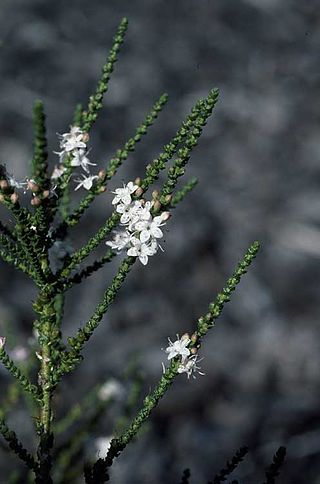
Myoporum cordifolium, commonly known as Jerramungup myoporum, is a plant in the figwort family, Scrophulariaceae. It is a shrub with thin, stiff branches and tiny, heart-shaped leaves, both covered with wart-like tubercles. Single white flowers with purple spots develop in the leaf axils and are followed by wrinkled green or brown fruits. It is endemic to a small area in the south-west of Western Australia
Diocirea acutifolia is a plant in the figwort family, Scrophulariaceae and is endemic to a small area near Norseman in Western Australia. The branches and leaves produce sticky resin which sometimes covers the whole plant making it appear bluish grey. This species is distinguished from the three others in the genus by its leaves which are longer than 6 millimetres (0.2 in) and the prominent resin glands on its stems.
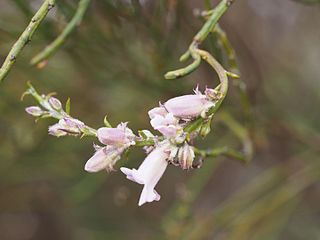
Eremophila dempsteri is a flowering plant in the figwort family, Scrophulariaceae and is endemic to the south of Western Australia. It is an erect shrub with many upright stems, short, hooked leaves and pinkish-purple to white flowers with distinctive woolly sepals.

Eremophila densifolia is a flowering plant in the figwort family, Scrophulariaceae and is endemic to the south-west of Western Australia. It is usually a low, spreading shrub with densely clustered leaves and lilac to purple flowers.

Eremophila drummondii, commonly known as Drummond's eremophila, is a flowering plant in the figwort family, Scrophulariaceae and is endemic to the south-west of Western Australia. It is a variable shrub, usually with sticky branches and leaves, long, thin leaves and mauve or purple flowers in spring.
Eremophila elderi, commonly known as aromatic emu bush, is a flowering plant in the figwort family, Scrophulariaceae. It is endemic to central Australia where it grows near the border between Western Australia, South Australia and the Northern Territory. It is an erect, aromatic shrub with sticky leaves and branches and usually pale coloured to white flowers. Its specific epithet (elderi) honours an early Australian businessman, Thomas Elder.
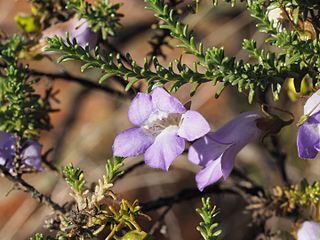
Eremophila exilifolia is a flowering plant in the figwort family, Scrophulariaceae and is endemic to Western Australia. It is a widely distributed shrub which is shaped like an inverted cone and has small, very sticky leaves and branches and lilac-coloured flowers.

Eremophila gibsonii is a flowering plant in the figwort family, Scrophulariaceae and is endemic to Australia. It is a sticky, glabrous, rounded shrub with narrow leaves and white to lilac-coloured flowers and which occurs in Western Australia, South Australia and the Northern Territory.
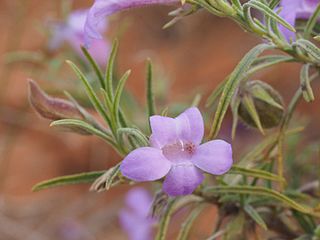
Eremophila gilesii, commonly known Charleville turkey bush, green turkey bush, desert fuchsia and Giles emu bush is a flowering plant in the figwort family, Scrophulariaceae and is endemic to Australia. It is usually a low, spreading shrub with pinkish-lilac to purple flowers and is widespread in the Northern Territory and all mainland states except Victoria. It is considered a difficult agricultural weed in some parts of Queensland but is often used as a bush medicine by Aboriginal people.

Eremophila ionantha is a flowering plant in the figwort family, Scrophulariaceae and is endemic to Western Australia. It is a shrub with many sticky branches, narrow, light green leaves and blue, purple or violet flowers.
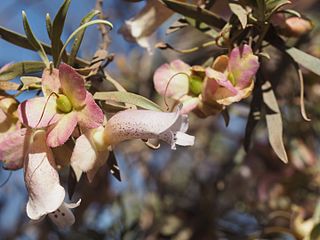
Eremophila platycalyx is a flowering plant in the figwort family, Scrophulariaceae and is endemic to Western Australia. It is a shrub or small tree with its branches and leaves covered with a layer of matted hairs, although the hairs are sometimes obscured by resin. The shape of the leaves is variable, depending on subspecies, the sepals are often brightly coloured and the petals are cream-coloured, sometimes spotted on the outside. Two subspecies have been described but others have been discovered although not as yet formally described.

Eremophila psilocalyx is a flowering plant in the figwort family, Scrophulariaceae and is endemic to Western Australia. It is an erect shrub with a broom-like shape, narrow, hooked leaves and white, pink, blue or purple flowers. It is common in the mallee country around Esperance. It was sometimes incorrectly known as Eremophila pachyphylla.

















